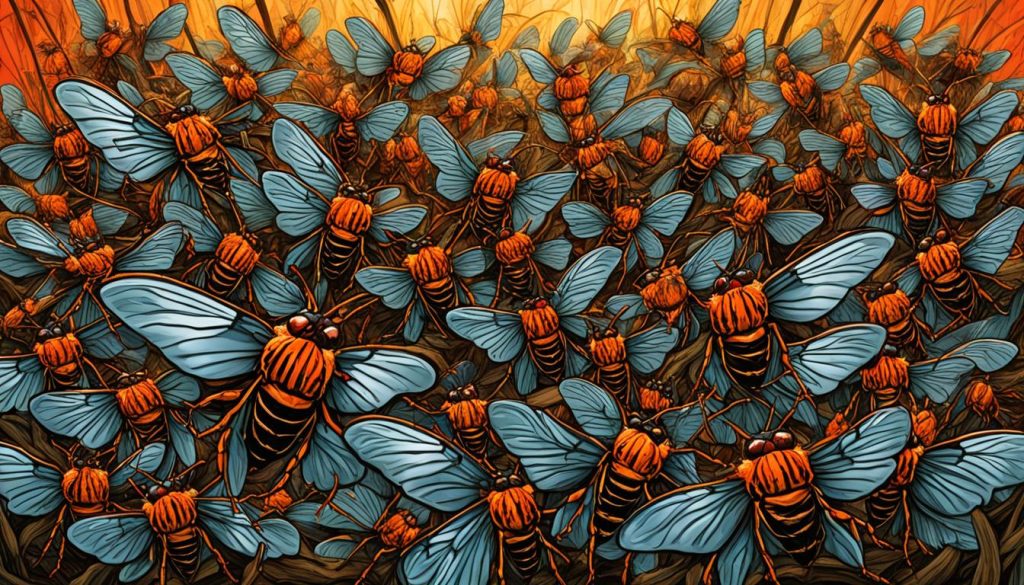Have you ever heard the captivating chorus of trillions of cicadas emerging from the ground after 17 years underground? These remarkable creatures, known as periodical cicadas, are about to put on a truly spectacular display. Millions of these “evolution’s bizarro wonders,” with their distinctive red eyes and peculiar pumps in their heads, are set to emerge across the eastern United States in numbers not seen in decades, or even centuries.

Unlike their green-tinged annual cousins, these Brood X cicadas, part of the Magicicada species, spend the vast majority of their lives – 17 years to be exact – underground, subsisting on the roots of trees. But when the soil temperature reaches a balmy 64°F, the adult cicadas will finally emerge, filling the air with their loud mating calls, which can reach up to a deafening 100 decibels.
What incredible secrets lie hidden in the life cycle of these remarkable insects? And how might their synchronized arrival impact the broader ecosystem? Let’s dive in and uncover the fascinating world of 17-year cicadas.
Key Takeaways
- Trillions of periodical cicadas, known as Brood X, are set to emerge across the eastern United States in 2021 after 17 years underground.
- These remarkable insects, distinct from their annual cousins, are “evolution’s bizarro wonders” with red eyes and pumps in their heads.
- Periodical cicadas spend the vast majority of their lives – 17 years – underground, subsisting on tree roots before emerging to mate and lay eggs.
- Their loud mating calls can reach up to 100 decibels, equivalent to the sound of a garbage disposal or lawn mower.
- The synchronized emergence of these cicadas in massive swarms is an evolutionary adaptation to ensure the species’ survival.
Trillions of Cicadas Emerge After 17 Years Underground
As the sun begins to warm the earth, the stage is set for one of nature’s most extraordinary spectacles – the emergence of Brood X, one of the largest geographic broods of periodical cicadas. These enigmatic insects, known for their synchronous 17-year life cycle, are about to emerge in staggering numbers across 15 states and Washington, D.C.
Brood X: The Largest Geographic Brood
Brood X is a testament to the incredible resilience and precision of these creatures. This particular brood is considered one of the largest geographically, spanning a vast territory from New York to Georgia, and as far west as Illinois. The trillions of 17-year cicadas that will soon take to the skies have been patiently waiting underground, feeding on tree roots, for nearly two decades.
Cicada Emergence Triggered by Soil Temperature
The timing of the cicada emergence is closely tied to the temperature of the soil. These insects are programmed to emerge when the soil reaches approximately 64°F at a depth of 12-18 inches, typically around mid-May. This intricate synchronization is a remarkable feat of evolutionary adaptation, ensuring that the cicadas emerge in unison to maximize their chances of finding mates and continuing their species.
Male Cicadas Emerge First, Followed by Females
The cicada life cycle follows a distinct pattern, with the male cicadas emerging first to begin their mating calls. These deafening serenades, which can reach up to 100 decibels, are designed to attract the females, who emerge shortly after their male counterparts. This coordinated emergence allows the cicadas to maximize their reproductive success, as the females lay their eggs in the branches of trees and shrubs.
The Incredible Life Cycle of periodical cicadas
The life cycle of periodical cicadas is truly remarkable, as revealed by the second and third sources. After emerging from the ground, these fascinating insects shed their old shells and develop their iconic wings. This process of cicada molting is a crucial step in their transformation, preparing them for the next phase of their life cycle.
Cicadas Shed Their Shells and Develop Wings
Once the periodical cicadas have shed their old exoskeletons, they are ready to take to the skies. Their newly formed wings allow them to soar and seek out potential mates, a critical part of their life cycle. This shedding process is a testament to the resilience and adaptability of these remarkable creatures.
Finding a Mate and Laying Eggs
With their wings fully developed, the periodical cicadas embark on a quest to find a suitable mate. The males use their distinctive, loud mating calls to attract the attention of females, engaging in a chorus of courtship displays. Once a pair has found each other, the females will then lay their eggs at the ends of tree branches, ensuring the next generation of cicada eggs has the best chance of survival.
The Next Generation: 17 Years Underground
The newly hatched cicada nymphs then drop to the ground and burrow underground, where they will spend the next 17 years feeding on tree roots and patiently waiting for their turn to emerge. This extraordinary periodical cicada life cycle is a testament to the resilience and adaptability of these remarkable creatures, as they navigate the rhythms of nature and ensure the continuation of their species.
The Mesmerizing Mating Calls of Cicadas
The periodic emergence of cicadas is marked by an orchestral symphony of mating calls, as the male cicadas strive to attract their female counterparts. According to the second and third sources, these cicada mating calls are truly captivating, involving a complex repertoire of sounds and behaviors.
Chorus, Courtship Calls, and Wing Flicks
The male cicadas begin their courtship by joining in a cicada chorus, producing a deafening, synchronized buzz that can be heard for miles. As they seek out potential mates, the males also employ a series of cicada courtship calls, ranging from a soft ticking to a loud, screeching series of notes. Additionally, some species use wing flicks and other visual displays to further entice the females.
Deafening Decibel Levels: Up to 100 dB
The intensity of these cicada sounds is truly impressive, with the mating calls reaching up to 100 decibels in volume. This is equivalent to the noise level of a garbage disposal, lawn mower, or jackhammer, making the cicada chorus a truly mesmerizing and overwhelming experience for anyone lucky enough to witness it.
Cicada Swarms: Nature’s Survival Strategy
The periodic emergence of periodical cicada swarms is a remarkable evolutionary adaptation that ensures the survival of these fascinating insects. With trillions of cicadas emerging simultaneously, the sheer volume of their presence overwhelms potential predators, allowing a significant portion of the cicada population to successfully mate and lay eggs.
This synchronized emergence is a testament to the incredible resilience of periodical cicadas. By emerging en masse, they create a feeding frenzy that predators simply cannot keep up with, ensuring that enough cicadas will survive to continue the cycle. This remarkable strategy has allowed periodical cicadas to thrive for millions of years, despite the threats posed by a wide range of natural predators.

The synchronized cicada emergence is not just a marvel of nature, but also a critical component of the ecosystem. Many other species, from birds to mammals, have adapted their own reproductive cycles to coincide with the arrival of these abundant food sources, further highlighting the important role that periodical cicadas play in the broader web of life.
As we continue to explore and understand the fascinating biology and behavior of periodical cicadas, it becomes increasingly clear that their evolutionary adaptation to survive through massive swarming events is a true testament to the ingenuity and resilience of the natural world.
The Impact of Human Development on Cicada Populations
While the periodic emergence of trillions of periodical cicadas is a remarkable natural spectacle, the impact of human development and climate change may be disrupting their delicate life cycles. According to the latest research, human-driven factors are increasingly influencing these ancient insects’ populations and behavior.
Climate Change and Early Emergences
There is growing evidence that some cicada broods are now emerging several years earlier than expected, which scientists believe may be linked to shifting temperature patterns due to human-caused climate change. As global temperatures rise, the soil temperature cues that trigger cicada emergence appear to be occurring sooner, causing these insects to break from their 17-year underground slumber ahead of schedule.
Insect Population Declines Worldwide
Sadly, the story of the periodical cicadas is not unique – insect population declines have been documented around the world, with habitat loss from human development and other factors taking a severe toll. This trend is deeply concerning, as insects play vital roles in healthy ecosystems, serving as pollinators, decomposers, and food sources for countless other species.
As we continue to encroach on natural habitats and alter global climate patterns, the future of the periodic cicada and countless other insect species hangs in the balance. Protecting these remarkable creatures will require a concerted effort to mitigate the impacts of human development and climate change.
Citizen Science: Mapping the Emergence of Brood X
As the highly anticipated Brood X cicadas prepare to emerge after their 17-year subterranean slumber, citizen scientists are playing a crucial role in documenting this natural phenomenon. Through the power of mobile apps like Cicada Safari and iNaturalist, individuals across the affected regions can now contribute to the scientific understanding of these remarkable insects.
Cicada Safari and iNaturalist Apps
The Cicada Safari app, developed by researchers at Mount Saint Joseph University, allows users to easily identify and record sightings of Brood X cicadas. By uploading photos and reports, citizen scientists are providing valuable data that helps scientists track the cicadas’ emergence patterns and geographic distribution. Similarly, the popular iNaturalist app, which facilitates nature observation and species identification, has become a hub for citizen science efforts focused on cicada mapping and population tracking.
Tracking Range Shifts and Population Changes
The influx of observations from citizen scientists using these apps is crucial for understanding how Brood X and other cicada populations are responding to environmental changes, such as climate change. By comparing current cicada sightings with historical data, researchers can detect any range shifts or changes in population dynamics that may be occurring. This information can help scientists develop a more comprehensive understanding of the long-term trends and factors influencing these remarkable insects.

The collaborative efforts of citizen scientists, empowered by mobile apps, are revolutionizing the way we study and appreciate the natural world. As Brood X emerges, the public’s participation in cicada mapping and population tracking initiatives will provide invaluable insights that advance our understanding of these captivating creatures.
Cicadas: A Boon for Other Animal Species
The periodic appearance of cicadas in massive numbers provides a significant boon for many other animal species. According to the sources, numerous animals time their own reproductive cycles to coincide with the cicada emergence, allowing them to successfully feed even more of their young than they might otherwise.
The abundance of cicadas serves as a valuable food source for a wide range of predators, from birds and mammals to reptiles and amphibians. This ecosystem benefit helps to support thriving animal populations in the areas where cicadas emerge. Researchers have observed that the influx of cicadas as food can lead to increased breeding and survival rates for many species, contributing to the overall ecological balance.
The periodic nature of the cicada life cycle also plays a crucial role in maintaining the delicate balance of animal populations and the broader ecosystem benefits. By emerging in synchronized, massive numbers, cicadas overwhelm their predators, ensuring that a significant portion of the population is able to successfully mate and lay eggs, perpetuating the cycle for the next generation.
Living with Cicadas: Tips and Advice
As the highly anticipated Brood X cicadas emerge across the eastern United States, many residents are wondering how to best manage their arrival. While these remarkable insects are generally harmless to humans, they can pose some temporary challenges for homeowners and pet owners alike. Let’s explore a few practical tips to help you navigate the cicada season.
Protecting Trees and Plants
One of the primary concerns with the cicada invasion is the potential damage they can cause to young, tender trees and shrubs. The female cicadas use their sharp ovipositors to deposit their eggs in the tips of tree branches, which can lead to branch dieback and distortion. To protect your plants, consider covering them with netting or mesh during the peak of the cicada emergence. This will deter the females from laying their eggs in your valued vegetation.
Dealing with Cicadas in Your Yard
As millions of cicadas emerge, you may find your yard and outdoor spaces inundated with these noisy critters. While their presence may be overwhelming at times, remember that this is a natural phenomenon that occurs every 17 years. Try to embrace the experience and enjoy the unique sounds of the cicada chorus. If the sheer number of cicadas becomes a nuisance, you can use a shop-vac or garden hose to gently remove them from areas where they congregate.
Are Cicadas Harmful to Pets?
For pet owners, the arrival of cicadas can raise concerns about the potential risks to their furry companions. The good news is that cicadas are generally not harmful to pets. In fact, many animals, including dogs and cats, may find the cicadas to be a tempting treat. However, it’s still important to monitor your pets to ensure they don’t overindulge, as consuming large quantities of cicadas could potentially cause digestive issues. As with any outdoor activity, it’s wise to keep a close eye on your pets during the cicada emergence.

